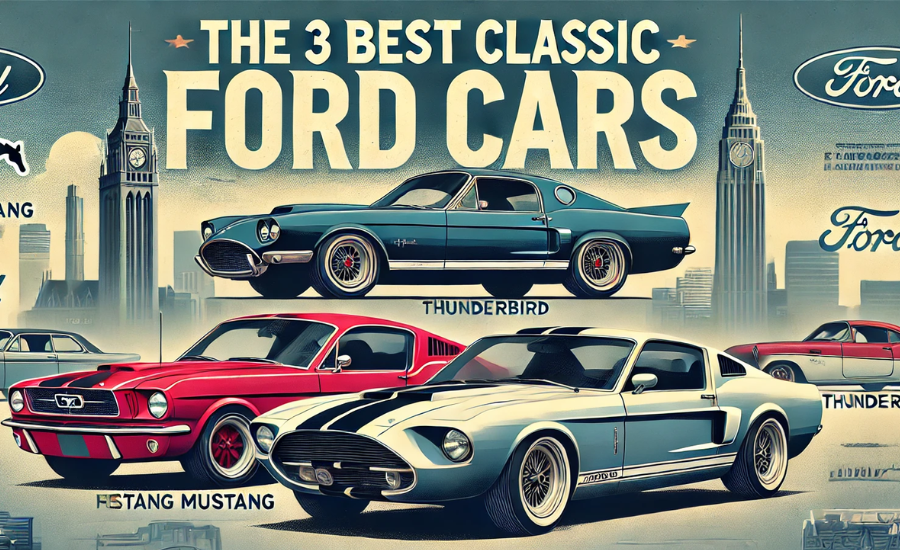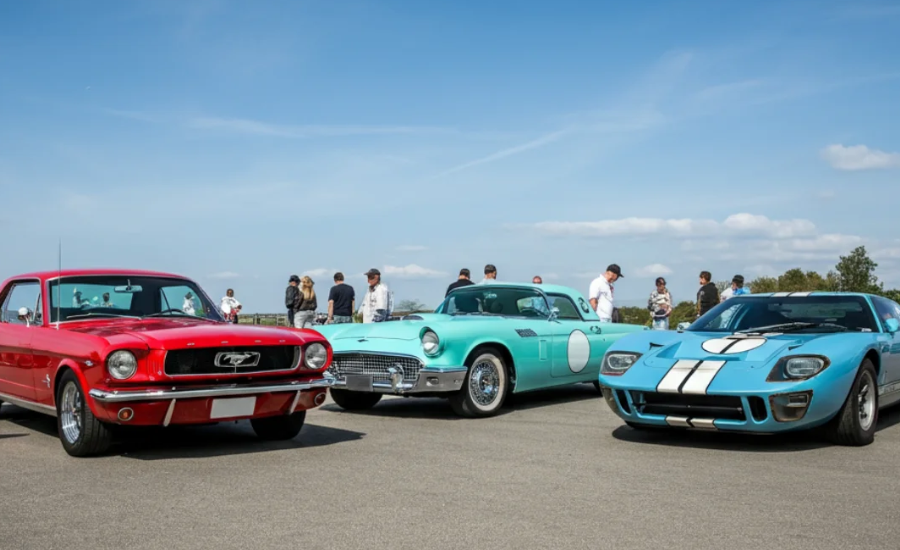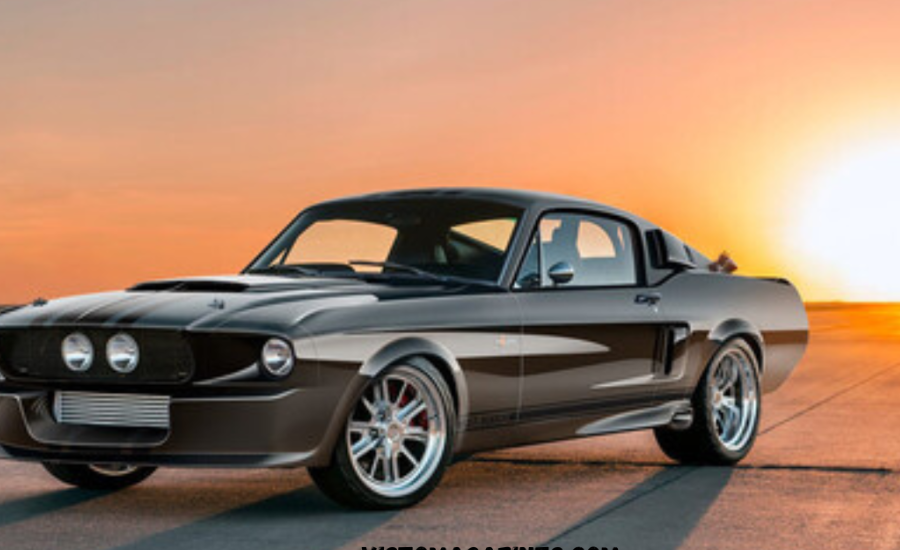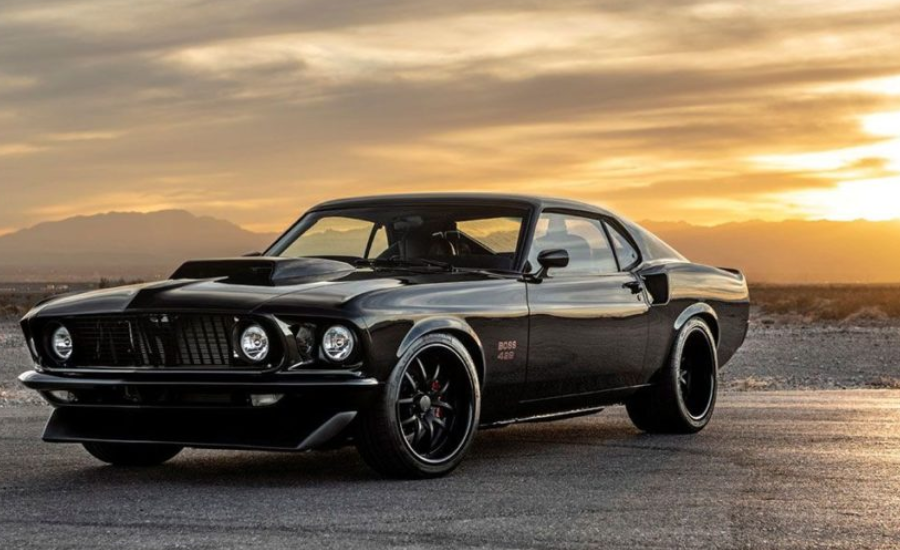https://guia-automovil.com/2020/10/07/los-3-mejores-autos-clasicos-de-ford is a name synonymous with classic American automobiles, with several of its models standing as testaments to the brand’s lasting influence on the automotive world. These vehicles have not only left an indelible mark on car culture but have also become symbols of innovation, style, and performance. Ford’s classic cars, such as the Mustang, GT40, and Thunderbird, continue to hold a revered place in automotive history due to their design, engineering, and legacy.
One of the most iconic Ford models is the Mustang, which made its debut in 1964. This car quickly became a symbol of freedom and the spirit of rebellion, attracting enthusiasts with its sleek design and powerful performance. Over the decades, the Mustang has remained a beloved staple, consistently outselling its competitors and cementing its status as an automotive icon.
Another notable model, the Ford GT40, is a true testament to Ford’s engineering excellence. The GT40’s success at the prestigious Le Mans 24 Hours race in the 1960s marked a significant achievement in motorsport, showcasing Ford’s dedication to pushing the boundaries of racing technology and performance. Its remarkable triumphs on the track continue to inspire admiration for its design and engineering.
The Top 3 Classic Ford Cars That Defined Automotive History

https://guia-automovil.com/2020/10/07/los-3-mejores-autos-clasicos-de-ford, a pioneer in the automotive world since its inception in 1903, has long been associated with groundbreaking innovation and exceptional engineering. Over the years, the brand has produced some of the most revered vehicles in automotive history, offering a perfect blend of performance, style, and durability. The company’s legacy is built on models that not only stand out for their technological advancements but also for their timeless designs that continue to captivate car enthusiasts and collectors alike.
Among Ford’s most iconic creations, three classic cars have earned legendary status due to their lasting influence on automotive culture. These vehicles are celebrated not just for their performance but for the way they embody the spirit of their respective eras. The Ford Mustang, GT40, and Thunderbird are more than just cars—they represent milestones in automotive history that continue to evoke admiration and respect.
The Mustang, with its aggressive yet sleek design, redefined the sports car market when it debuted in the 1960s. The GT40 became a symbol of racing dominance with its remarkable success at Le Mans, while the Thunderbird combined luxury with performance, making it an instant status symbol. These Ford classics continue to capture the imagination of car lovers around the world.
Ford Thunderbird: A Perfect Fusion of Luxury and Performance
The https://guia-automovil.com/2020/10/07/los-3-mejores-autos-clasicos-de-ford, first introduced in 1955, stands as one of the most iconic vehicles in automotive history. Initially designed to compete with high-performance cars like the Chevrolet Corvette, the Thunderbird quickly carved out its own niche as a luxury vehicle that offered both elegance and power. Over the years, it has become a symbol of sophistication, setting the standard for personal luxury cars and showcasing Ford’s ability to combine advanced engineering with timeless design.
What truly set the Thunderbird apart was its perfect blend of stylish aesthetics and robust performance. Under the hood, it boasted a powerful V8 engine, providing the speed and power that enthusiasts craved. Inside, the Thunderbird featured a refined and comfortable interior, offering a level of luxury that appealed to those who sought more than just a fast car. Whether cruising down the highway or parked in the driveway, the Thunderbird exuded an air of class and performance.
Throughout its production, the Thunderbird underwent several redesigns, each version maintaining the brand’s commitment to luxury while adapting to modern tastes. Despite these changes, it always remained a core model in Ford’s lineup, known for its ability to offer the best of both worlds—luxury and performance.
Ford Mustang A Timeless Symbol of Automotive Excellence

The Ford Mustang, first unveiled in 1964, is widely regarded as one of the most influential cars in automotive history. This groundbreaking model not only helped define the muscle car genre but also shaped the identity of American automotive culture. The Mustang’s introduction marked a turning point in the industry, capturing the hearts of car enthusiasts and the imagination of an entire generation.
What made the Mustang stand out from the crowd was its combination of high-performance power, striking design, and a unique presence on the road. With a range of powerful engine options and a sleek, aggressive look, the Mustang became an instant success, representing freedom, rebellion, and the spirit of the open road. Its ability to combine thrilling performance with style set it apart as a true icon.
Over the years, the Mustang has continued to evolve, with each new iteration maintaining the essence of the original while incorporating modern innovations. Despite these updates, the Mustang has never lost its signature charm, consistently drawing fans from all walks of life. Today, it remains a proud symbol of Ford’s legacy, a classic that continues to thrive in the ever-changing world of automotive design and technology.
Ford GT40: A Legendary Icon of Racing Excellence
The Ford GT40 stands as a monumental achievement in the world of motorsport, widely regarded as one of the most celebrated cars in Ford’s history. Originally designed with one goal in mind—defeating Ferrari at the renowned Le Mans 24-hour race—the GT40 became an iconic symbol of speed, engineering excellence, and triumph. Its unparalleled success at Le Mans, securing four consecutive victories from 1966 to 1969, solidified its place among the most legendary sports cars in automotive history.
Engineered for peak performance, the Ford GT40 was built with a mid-mounted engine that provided superior weight distribution, allowing for exceptional handling and acceleration. Its sleek, aerodynamic design was crucial in achieving the high speeds necessary to dominate on the racetrack. With its combination of raw power and precision engineering, the GT40 became a formidable contender, outshining its competitors and establishing Ford’s legacy in the world of endurance racing.
Although only a limited number of GT40 models were produced, the car’s influence continues to be felt in the automotive industry. Its innovative design has inspired the development of modern sports cars, making the Ford GT40 not just a piece of racing history, but a lasting symbol of Ford’s commitment to pushing the boundaries of performance.
The Art of Restoring Classic Ford Cars: A Passion for Preservation

Restoring classic Ford cars has evolved into more than just a hobby; it’s a labor of love that allows automotive enthusiasts to breathe new life into some of the most iconic vehicles in history. The process of reviving classic models like the Ford Mustang, Thunderbird, and GT40 involves much more than simply refurbishing old parts—it’s about preserving the vehicle’s original charm while enhancing it with modern advancements. For many, this craft becomes a personal journey to reconnect with the craftsmanship and design that made these cars legendary.
A typical restoration project may span several years, depending on the condition of the vehicle and the goals of the restorer. One of the key challenges is maintaining the car’s authenticity, ensuring that it retains the same visual appeal and driving experience as when it first rolled off the production line. However, modern technology plays a crucial role in making these classic cars more practical for today’s roads. Many restorations include upgrades like advanced safety features, improved suspension systems, and enhanced performance capabilities, which help ensure that these vintage machines can still be enjoyed in the modern world.
The outcome of a well-executed restoration is a seamless blend of past and present—resulting in a car that is not only beautiful but also safe, reliable, and enjoyable to drive.
The Enduring Legacy of Classic Ford Cars

Classic Ford vehicles, such as the Mustang, Thunderbird, and GT40, continue to captivate car enthusiasts for several reasons—chief among them is their remarkable blend of performance, design, and historical significance. These iconic models were created during an era when Ford’s commitment to innovation and engineering excellence shaped the brand’s identity. Their influence remains alive in the latest Ford offerings, demonstrating how the company consistently marries its rich history with state-of-the-art technology.
For car collectors, classic Ford cars are not just prized possessions; they are symbols of automotive history. Each car represents a pivotal moment in the evolution of car design and manufacturing, making them highly sought after by those who appreciate the craftsmanship behind these machines. Owning a classic Ford goes beyond just having a car; it’s like owning a piece of automotive culture. Restoring or maintaining these cars is a dream for many, as it allows them to connect with a legacy that continues to inspire new generations of car lovers.
Whether it’s for display, performance, or nostalgia, classic Ford cars offer an unparalleled experience that blends the charm of the past with the allure of timeless automotive craftsmanship. They embody the spirit of innovation that has kept Ford at the forefront of the automotive world.
Classic Ford Cars Icons in Popular Culture
The influence of classic Ford vehicles extends far beyond the realm of automobiles, with these iconic cars becoming ingrained in global popular culture. Throughout the decades, models like the Ford Mustang, Thunderbird, and GT40 have appeared in various films, television shows, and other media, reinforcing their status as symbols of style, performance, and American engineering excellence.
The Ford Mustang, for instance, made an unforgettable impact through its prominent role in films such as Bullitt (1968) and Gone in 60 Seconds (2000). Its thrilling high-speed chases and unmistakable design made it a favorite among moviegoers, cementing its place in cinematic history. Similarly, the Ford Thunderbird captured the spirit of freedom and adventure in Thelma & Louise (1991), representing more than just a car but an escape into a world of possibility.
Another significant Ford vehicle, the GT40, was brought to life on the big screen in Ford v Ferrari (2019). This film not only showcased the car’s engineering marvel but also highlighted Ford’s ambitious journey to conquer the legendary Le Mans race, further embedding the GT40 as a symbol of passion and competitive spirit.
Through these films and cultural milestones, these classic Ford cars have earned their place as true icons of automotive history, reflecting the innovation and legacy that continue to inspire today.
The Enduring Influence of Classic Ford Cars in Today’s Automotive World

Classic Ford cars, although born in an earlier era, continue to have a profound influence on the modern automotive industry. Ford has skillfully preserved the essence of these iconic vehicles, ensuring that their legacy endures through contemporary models that pay homage to their predecessors. The Ford Mustang, for example, remains a symbol of American performance and muscle, with each new iteration maintaining the robust engine power and sleek styling that first earned the Mustang its legendary status. The latest Mustang models incorporate cutting-edge technology while staying true to the spirit of the original.
In addition, the Ford GT has made a remarkable comeback, proving that the brand’s racing heritage is as relevant today as it was in the 1960s. The new Ford GT, a limited-production supercar, continues to represent Ford’s dedication to high-performance engineering, echoing the groundbreaking success of the original GT40 at Le Mans.
While Ford no longer produces the Thunderbird, the luxury and sophistication it once embodied lives on in the brand’s premium offerings. These modern vehicles capture the elegance and advanced features that made the Thunderbird a symbol of status and refinement, ensuring that its legacy remains intact in Ford’s modern-day lineup. Through these models, Ford showcases the lasting influence of its classic cars.
Facts
- Ford Mustang:
First introduced in 1964, the Ford Mustang is a symbol of American performance and rebellion, with a reputation for sleek design and powerful engines.
- Ford GT40:
The Ford GT40 made history by winning four consecutive Le Mans 24-hour races from 1966 to 1969, showcasing Ford’s commitment to racing excellence.
- Ford Thunderbird:
Launched in 1955, the Thunderbird is a luxury vehicle that combines high-performance with elegant design, setting the standard for personal luxury cars.
- Influence in Popular Culture:
Classic Ford cars like the Mustang, Thunderbird, and GT40 have been featured prominently in films and television shows, cementing their status as cultural icons.
- Restoration of Classic Models:
Restoring classic Ford cars, such as the Mustang and GT40, has become a popular hobby, blending modern upgrades with historical design elements to preserve their legacy.
- Modern Iterations:
Ford continues to honor the legacy of these classic models with updated versions of the Mustang, Ford GT, and other vehicles, blending cutting-edge technology with classic styling.
FAQs
Q: What makes the Ford Mustang so iconic?
A: The Ford Mustang’s combination of powerful performance, sleek design, and symbolic representation of freedom and rebellion has cemented its status as an automotive icon.
Q: How did the Ford GT40 become famous?
A: The Ford GT40 became famous for its dominance in the Le Mans 24-hour race, where it secured four consecutive victories from 1966 to 1969, showcasing Ford’s engineering excellence.
Q: What is special about the Ford Thunderbird?
A: The Ford Thunderbird is known for its perfect blend of luxury and performance. It offered both a powerful engine and a refined, comfortable interior, becoming an instant symbol of sophistication.
Q: How has Ford preserved the legacy of its classic cars?
A: Ford continues to produce updated versions of its classic models like the Mustang and GT, maintaining their original design elements while integrating modern technology and performance capabilities.
Conclusion
Ford’s classic cars, including the Mustang, GT40, and Thunderbird, have not only shaped the automotive landscape but also established a lasting legacy in popular culture. These vehicles remain icons of innovation, performance, and style, and Ford continues to honor their heritage by introducing modern versions that blend cutting-edge technology with the timeless design that made these cars legendary. The enduring appeal of these classics reflects the lasting influence Ford has had on both the automotive industry and global culture. Whether restored for their historical value or enjoyed in their updated forms, these vehicles continue to captivate car enthusiasts worldwide.
Stay In Touch For More Updates And Alerts! Tech Pro Billion




